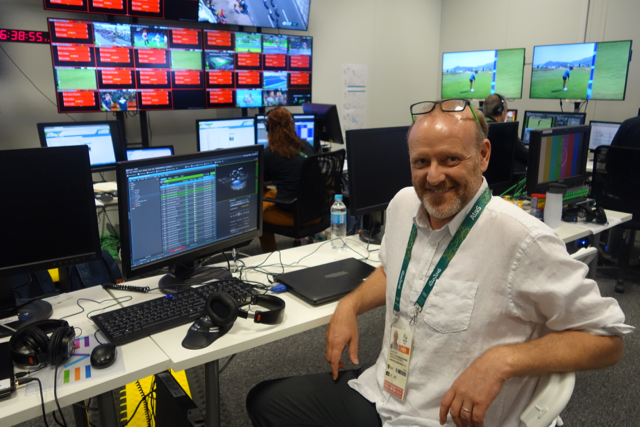Live from Rio 2016: Matt Millington, Head of Digital for OBS, On the Power of the OVP
The Olympic games not only attracts a wide range of nationalities and athletes but also a wide range of broadcasters with some looking forward to a day when 8K HDR is the norm and others simply trying to manage the transition to HDTV. That disparity is why Olympic Broadcasting Services (OBS) does everything in its power to make sure new service offerings are as easy to deploy as possible.

OBS Head of Digital Matt Millington inside the OVP production area.
That’s one of the reasons OBS is once again offering the Olympic Video Player (OVP) an advanced video player that is designed to make it as easy as possible for rights holders to deliver digital content to Web browsers, tablets, and phones. The 2016 Rio Games are the first summer Olympics to have OVP available as a service (it debuted at the Sochi Winter Games in 2014). Not only does it offer live content, complete events on demand, and highlights but it also offers in-depth statistics, and more. For example, while watching coverage of the golf events a user can access a digital scorecard for golfers and click on birdies or eagles and bring up highlights from that hole even if the coverage never made it to air.
The Olympic Video Player is also available in a white label service so that all a rights holder has to do is lay in some branding of their channel or network.
“Some of the rights holders are passive and happy for us to do everything, and for six of the rights holders we look after their service and give them a neutral view of the action,” says Matt Millington, OBS, head of digital. “Other rights holders are more proactive and manage their own home pages, videos, commentaries, and news stories with larger teams creating extra content.”
All live sports sessions are passed through to the OVP and the broadcast data feed is used to ensure the stream starts and stops at the correct time as sometimes an event will start later than anticipated due to prior competition, etc.
The production team for the OVP is an example of a lean-and-mean production team with eight producers, three EVS operators, and a technical team of about six people cranking away on the service and also leveraging the content creation power of the entire OBS organization.
“Given the high-number of mobile devices that are using the OVP everything is available in short form highlights as the Olympic News Channel team is creating more than 1,300 highlight pieces,” says Millington. “So our team will look at those, add a thumbnail, and make it available to viewers.”
Prior to joining the OBS team Millington was the BBC producer in charge of streaming the 2012 Summer Olympics to viewers across the UK. It was a high-pressure post that not only pushed the limit of Millington and his team but also the entire industry as it set a new bar for digital engagement but also helped put digital services into the spotlight.
“I have been working in digital for many years and when I first started digital were the difficult ones banging on the doors of broadcasters asking if we can use some content and we were seen as a bit of a pest,” he says. “Now things have changed and we are seen as an integral part of everyone’s workflow and we rarely run into any resistance. We have the cooperation we need to make sure the content available from the broadcast is in the right format and content structure for digital playout.”
Millington says that the philosophical approach to the streaming effort approaches it from two angles. First, there is the need to meet the demands of the aficionado who not only wants all of the action but also the hard data and plenty of stats.
“But then, for many viewers, this will be the first time they are watching a sport or the first time they have watched it in four years,” says Millington. “So we make sure we cater to both audiences. We have all the extra information for the aficionado but also present it in a user-friendly way that makes sense to a newcomer to the sport. And we have sport guides to explain a sport to those who are new to it.”
Perhaps the greatest benefit of streaming complete events is that the production team involved with the primary broadcast TV window have more flexibility in storytelling.
“They no longer are under the same pressures to offer all of the content on one or two channels,” says Millington. “And when there is a clashing event they can tell the viewers to switch over to online or the app to watch an event while the broadcast can focus on gold-medal performances.”

